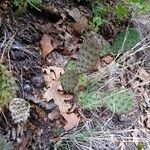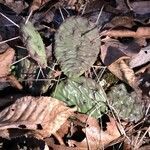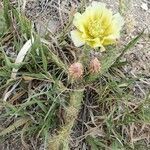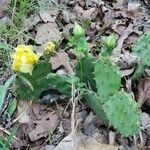Shrubs, forming clumps, 7.5-16 cm, sometimes from tuberlike rootstocks. Stem segments not easily detached, dark dull green, often cross wrinkled when stressed, flattened, obovate to circular, 5-11 × 3.5-7.5 cm, fleshy (to flabby and cross wrinkled when stressed), tuberculate, glaucous; areoles 5-6(-8) per diagonal row across midstem segment, oval to subcircular, 2-4 mm diam.; wool tan. Spines (0-)1-4 per areole, usually in distal areoles, erect to spreading, white to red-brown, acicular, straight, terete or 1 flattened, ± stout (0.5 mm diam. at base), longest to 60 mm. Glochids in dense tuft, pale yellow, tan to red-brown, aging brown, to 5 mm. Flowers: inner tepals yellow with red basal portions, 25-40 mm; filaments pale yellow; anthers yellow; style white; stigma lobes cream to yellowish. Fruits green to yellowish to dull red, stipitate, elongate-obovoid, 25-40 × 15-28 mm, fleshy, glabrous; areoles 16-28. Seeds tan, subcircular, 4-5 mm, thickish, warped; girdle broad, protruding to 0.5 mm. 2n = 44.
More
Prostrate and spreading, forming mats to 1.5 m wide; usually some roots tuberous-thickened; joints of the stem mostly 6–10 × 5–7 cm, flat, orbicular to obovate; areoles on full-grown joints 15–30 mm apart, with (1–)3–6 spines 3.5–5.5 cm; fls yellow with reddish center, 5–7 cm wide; outer sep ovate, acute to acuminate; fr reddish-purple, 2.5–4 cm, juicy; seeds discoid with a rough, irregular, corky margin. Prairies and plains; S.D. to Ariz. and Tex., e. occasionally to Wis., s. Mich., Ill., and reputedly O. and Ky. May–July. (O. mesacantha; O. tortispina, misapplied) O. polyacantha Haw., a similar western sp. with 6–10 spines per areole and dry frs, has been reported e. to Wis. and Mo.
A low spreading cactus. It forms low clumps 13 cm high and 2 m wide. It has fleshy or woody roots. The stem segments are round and blue-green. They are 5-10 cm long by 5-6 cm wide. There are 1-6 spines per group. They are often bent backwards and are 3.8-5.6 cm long. The flowers are yellow and may be tinged with red. They are 5-6 cm long and 5-6 cm wide. The fruit are oval and purple or red. They are 2.5-4 cm long and 2.5-3 cm wide.
Sandy, gravelly or rocky soil in grasslands, xerophyllous scrub and pine-juniper forests; at elevations from 600-2,100 metres. Plants can sometimes persist for years under invading trees.
More
It grows in dry prairie. It grows on sand, gravel or rocky soils. It grows between 600-2,300 m altitude in California.





